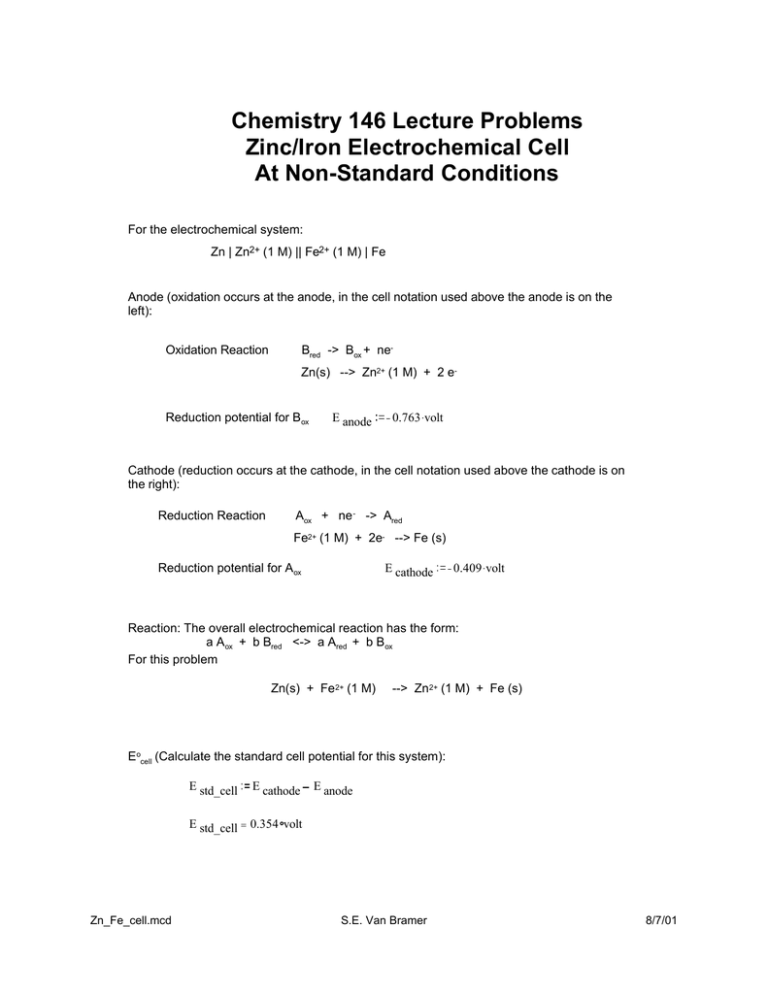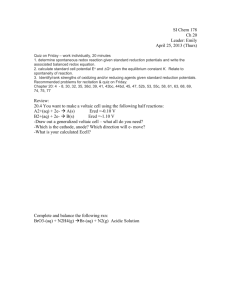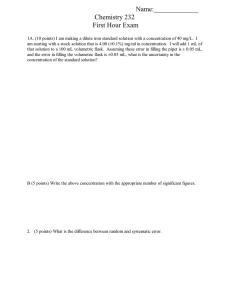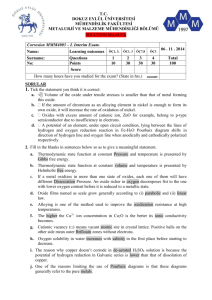Chemistry 146 Lecture Problems Zinc/Iron Electrochemical Cell At
advertisement

Chemistry 146 Lecture Problems Zinc/Iron Electrochemical Cell At Non-Standard Conditions For the electrochemical system: Zn | Zn2+ (1 M) || Fe2+ (1 M) | Fe Anode (oxidation occurs at the anode, in the cell notation used above the anode is on the left): Bred -> Box + ne- Oxidation Reaction Zn(s) --> Zn2+ (1 M) + 2 e- Reduction potential for Box E anode 0.763 .volt Cathode (reduction occurs at the cathode, in the cell notation used above the cathode is on the right): Reduction Reaction Aox + ne - -> Ared Fe2+ (1 M) + 2e- --> Fe (s) Reduction potential for Aox E cathode 0.409 . volt Reaction: The overall electrochemical reaction has the form: a Aox + b Bred <-> a Ared + b Box For this problem Zn(s) + Fe2+ (1 M) --> Zn2+ (1 M) + Fe (s) Eocell (Calculate the standard cell potential for this system): E std_cell E cathode E anode E std_cell = 0.354 volt Zn_Fe_cell.mcd S.E. Van Bramer 8/7/01 Ecell calculation with the Nernst Equation (This step is required any time the system is not at the "standard state". In the "standard state" concentrations are 1 M, pressure is 1 atm, and temperature is 298.15 K) In this problem you were given a series of different concentrations to use for these calculations: 20 ) .K Temperature T ( 273.15 Faraday's Constant: F 96485.309 . coul mole Gas Law Constant: R 8.314510 . Number of electrons in balanced redox reaction: n 2 Define Molarity M joule mole .K mole liter For each example you are given a concentration for Zn2+ and Fe2+. The following additional calculations are required to solve: Concentration anode: C Zn2 1 .M Concentration cathode: C Fe2 1 .M Equlibrium Quotient (Q) Nernst Equation: The Cell potential: Zn_Fe_cell.mcd Q C Zn2 C Fe2 E cell E std_cell R .T . ln( Q ) n .F E cell = 0.354 volt S.E. Van Bramer 8/7/01 Now Repeat for other concentrations C Zn2 1 .M E cell E std_cell C Fe2 2 .M Q C Zn2 C Fe2 R .T . ln( Q ) n .F E cell = 0.363 volt Now Repeat for other concentrations C Zn2 2 .M E cell E std_cell C Fe2 1 .M Q C Zn2 C Fe2 R .T . ln( Q ) n .F E cell = 0.345 volt Now Repeat for other concentrations C Zn2 0.1 .M E cell E std_cell C Fe2 0.1 . M Q C Zn2 C Fe2 R .T . ln( Q ) n .F E cell = 0.354 volt Now Repeat for other concentrations C Zn2 1.0 .M E cell E std_cell C Fe2 0.01 . M Q C Zn2 C Fe2 R .T . ln( Q ) n .F E cell = 0.296 volt Now Repeat for other concentrations Zn_Fe_cell.mcd C Zn2 0.01 . M E cell E std_cell C Fe2 1 .M Q C Zn2 C Fe2 R .T . ln( Q ) n .F S.E. Van Bramer E cell = 0.412 volt 8/7/01 Calculating the equlibrium concentrations for a set potential For the electrochemical system: Zn | Zn2+ (1 M) || Fe2+ (1 M) | Fe Standard Potentials: 0.7628 .volt E anode E cathode n 0.409 . volt 2 Standard Cell Potential: E std_cell E cathode E anode E std_cell = 0.354 volt Applied Potential E applied 0.3538 .volt Since the applied potential controls the cell equlibrium: E cell E applied Rearanges the Nernst Equation to find Q: NOTE: Q exp Q reactants E cell E std_cell Q 2 products Zn 2 Fe R .T . ln( Q ) n.F E cell .n . F E std_cell .n .F ( R .T ) Q=1 Zn_Fe_cell.mcd S.E. Van Bramer 8/7/01 Repeat calculation for other applied potentials E cell 0.3538 .volt Q exp E cell 0.3530 .volt Q exp E cell 0.3400 .volt Q exp E cell 0.3550 .volt Q exp E cell 0.3600 .volt Q exp Zn_Fe_cell.mcd E cell .n . F E std_cell .n .F ( R .T ) E cell .n . F E std_cell .n .F ( R .T ) E cell .n . F E std_cell .n .F ( R .T ) E cell .n . F E std_cell .n .F ( R .T ) E cell .n . F E std_cell .n .F ( R .T ) S.E. Van Bramer Q=1 Q = 1.065 Q = 2.982 Q = 0.909 Q = 0.612 8/7/01





